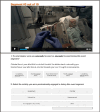Eye movements as predictors of student experiences during nursing simulation learning events
- PMID: 40591191
- PMCID: PMC12214182
- DOI: 10.1186/s41235-025-00640-7
Eye movements as predictors of student experiences during nursing simulation learning events
Abstract
Although the "eye-mind link" hypothesis posits that eye movements provide a direct window into cognitive processing, linking eye movements to specific cognitions in real-world settings remains challenging. This challenge may arise because gaze metrics such as fixation duration, pupil size, and saccade amplitude are often aggregated across timelines that include heterogeneous events. To address this, we tested whether aggregating gaze parameters across participant-defined events could support the hypothesis that increased focal processing, indicated by greater gaze duration and pupil diameter, and decreased scene exploration, indicated by smaller saccade amplitude, would predict effective task performance. Using head-mounted eye trackers, nursing students engaged in simulation learning and later segmented their simulation footage into meaningful events, categorizing their behaviors, task outcomes, and cognitive states at the event level. Increased fixation duration and pupil diameter predicted higher student-rated teamwork quality, while increased pupil diameter predicted judgments of effective communication. Additionally, increased saccade amplitude positively predicted students' perceived self-efficacy. These relationships did not vary across event types, and gaze parameters did not differ significantly between the beginning, middle, and end of events. However, there was a significant increase in fixation duration during the first five seconds of an event compared to the last five seconds of the previous event, suggesting an initial encoding phase at an event boundary. In conclusion, event-level gaze parameters serve as valid indicators of focal processing and scene exploration in natural learning environments, generalizing across event types.
Keywords: Event cognition; Mobile eye-tracking; Simulation education.
© 2025. The Author(s).
Conflict of interest statement
Declarations. Ethics approval and consent to participate: The research protocol for this study was approved by the Institutional Review Board (IRB) at Vanderbilt University and all procedures were conducted in accordance with the ethical guidelines and regulations outlined by the IRB. Consent for publication: Not applicable, images were generated from mock simulations and corresponding author’s eye-tracking footage. Competing interests: The authors declare that they have no competing interests.
Figures






Similar articles
-
Naturalistic Eye Movement Tasks in Parkinson's Disease: A Systematic Review.J Parkinsons Dis. 2024;14(7):1369-1386. doi: 10.3233/JPD-240092. J Parkinsons Dis. 2024. PMID: 39422967 Free PMC article.
-
Ocular working memory signals are flexible to behavioral priority and subjective imagery strength.J Neurophysiol. 2024 Jul 1;132(1):162-176. doi: 10.1152/jn.00446.2023. Epub 2024 Jun 5. J Neurophysiol. 2024. PMID: 38836298 Free PMC article.
-
Attention modulates subjective time perception across eye movements.Vision Res. 2025 Feb;227:108540. doi: 10.1016/j.visres.2025.108540. Epub 2025 Jan 7. Vision Res. 2025. PMID: 39778360
-
A validation study on the accuracy and precision of gaze and vergence using stereoscopic eye-tracking technology.Behav Res Methods. 2025 Jul 1;57(8):214. doi: 10.3758/s13428-025-02731-1. Behav Res Methods. 2025. PMID: 40593383 Free PMC article.
-
Health professionals' experience of teamwork education in acute hospital settings: a systematic review of qualitative literature.JBI Database System Rev Implement Rep. 2016 Apr;14(4):96-137. doi: 10.11124/JBISRIR-2016-1843. JBI Database System Rev Implement Rep. 2016. PMID: 27532314
References
-
- Anderson, J. R., Bothell, D., & Douglass, S. (2004). Eye movements do not reflect retrieval processes: Limits of the eye-mind hypothesis. Psychological Science,15(4), 225–231. - PubMed
-
- Bates, D., Maechler, M., Bolker, B., Walker, S., Christensen, R. H. B., Singmann, H., & Bolker, M. B. (2015). Package ‘lme4.’ Convergence,12(1), 2.
-
- Benner, P. (2004). Using the Dreyfus model of skill acquisition to describe and interpret skill acquisition and clinical judgment in nursing practice and education. Bulletin of Science, Technology & Society,24(3), 188–199.
-
- Benner, P. (1984). From novice to expert. Menlo Park, 84(1480), 10-1097.
MeSH terms
Grants and funding
LinkOut - more resources
Full Text Sources
